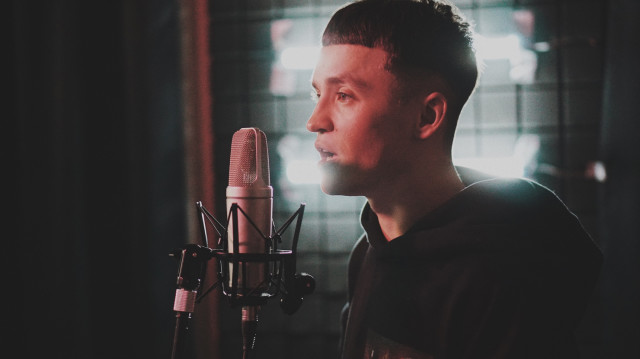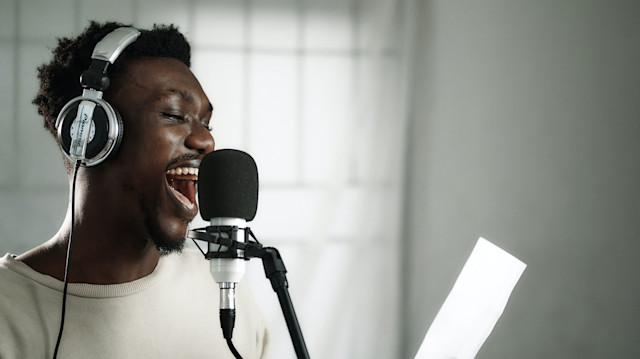The Secrets To Recording Pro Vocals & Voiceovers
Learn how to record crisp and clear vocals and voiceovers at home or in a studio. Find out what mics and equipment to use and what techniques you should consider to capture vocals that are streaming and radio ready!

Whether you're creating a song or a podcast, recording vocals can be one of the most challenging components of any audio production project. In every memorable pop song, podcast, or voiceover, the quality of the vocal recordings needs to be clear, smooth, and distinctive.
To achieve this level of quality while you’re recording vocals, you need to use the right recording tools. In this article, we’ll show you exactly how to set up your studio equipment and how to use recording software and techniques to record the kind of clear and crisp vocals you need to make your masterpiece stand out.
What is vocal recording?
Vocal recording is a key part of vocal production and the process by which audio producers capture a person's voice using audio recording software in the most effective way possible. However, there are different challenges in each type of vocal performance.
Challenges faced by vocal recording engineers
A vocalist’s main objective is to have their vocal performance resonate with their audience. The audio engineer recording a singer, rapper, or voiceover artist must approach their recording methods in distinct ways, each type comes with its own set of challenges.
Singing challenges: In singing, recording vocals means pulling from one’s diaphragm. Although it’s an excellent technique to belt out a chorus, singers often fall victim to microphone popping. In recordings, popping occurs when a big breath of air is expelled and strikes the microphone, leading to a lower level of professional quality.
Rapping challenges: Rapping is usually an explosive intense form of vocal performance. That naturally leads to the same popping problems as singers face, sometimes even more so. Another big challenge rappers face during recording is breath control. Because of the density between the words and bars in rapping, the performer sometimes has a hard time catching their breath in between the sentences.
Another challenge when recording rappers is the proximity of the vocalist. Rappers tend to move around more in their performance, even in the studio. This can lead to inconsistencies in the vocal signal, making it hard to get a good vocal mix later.
Voiceover challenges: Unlike musicians, voiceover artists aren’t typically working with background noise. The lack of background noise can be great because they don’t have to compete with an instrumental in their headphones. However, in voiceovers, the vocal is the only part that the listener will hear, which makes it that much more important to get a quality recording. Proximity to the mic and room acoustics are factors that can have big impacts on the quality of a voiceover and should be considered.
Removing background noise from vocals
If you happen to capture disturbing background noise in your vocal take, there are tools to help you remedy this. Soundtrap's Vocal Cleanup (Powered by AI) offers a smooth noise reduction processing that surgically removes any unwanted audio in vocal recordings.
Simply right-click on the vocal region and pull up the Vocal Cleanup in the Soundtrap studio. Let the AI software identify the disturbance and automatically remove it with the click of a button.
There are numerous other challenges that each type of vocal performer can face. From sibilance to poor room acoustics, mic placement, and even keeping the recording levels of the incoming signal too hot.
Recording vocals that are pleasing to the ear is a talent in its own right. Luckily, you can overcome many of these challenges with the right vocal recording equipment, great DAW software, and a few tips and tricks that we will cover in this post.
The most important equipment for recording vocals online
For many music producers and audio engineers, recording vocals is the most challenging component of any project. However, you can make the recording process much easier with the right recording equipment and software. The list of equipment used in vocal recordings is endless, but to get started, you'll need these essentials to get a professional-sounding recording.
Microphones. Of course, you'll need the right microphone to record vocals. While there are many options, a condenser microphone is a solid choice for most vocals. They're more sensitive than dynamic microphones to capture higher frequencies and greater detail. Check out this article on the best vocal microphones of 2023 before you invest.
Audio Interface. An audio interface bridges the gap between your microphone and your computer by converting the audio signal from your microphone into digital audio you can play on your computer.
Software. Your digital audio workstation (DAW) will allow you to record, edit, and mix your vocal recordings. While there are many different vocal recording tools, Soundtrap is great for recording your vocals directly online, without having to download expensive software or handling huge audio files on your computer.
Headphones. You must have the tools to hear yourself during the vocal recording process. High-quality headphones allow you to listen to your voice clearly within a controlled environment. Closed-back headphones are the ideal option for vocal recording because the sound will not travel to your microphone as you record.
Reflection filter. Many people fail to consider the importance of a reflection filter, but they're an essential piece of vocal recording equipment. A reflection filter should be placed behind the microphone to ensure sound does not bounce off the walls and reflect.
Pop filter. To take care of those hard consonants like Ps, Ts, and Ss, using a pop filter in front of the microphone is a great option to consider. This allows for smoother and less harsh recordings.
Mic stand. Using your hands to hold the microphone while singing is a bad idea. This leads to a bunch of distracting noises and proximity issues in the recording. Invest in a robust microphone stand that lets the singer focus on singing instead of fumbling around the mic in the recording session.
Now that you know which equipment to use, we'll give you a few tips to record vocals at home successfully.

Simple tips & techniques for recording vocals at home
Sometimes, recording vocals can become complicated, but these easy-to-follow tips streamline the vocal recording process.
Distance from the mic. When you're creating a vocal recording, the vocalist should be between 2 and 12 inches from the microphone. Although this depends on the type of microphone you're using and the space you have, the 2 and 12 rule is a good rule of thumb.
Warm up your voice. Even if you're creating a podcast, it's essential to warm up your vocal cords before you begin recording. Consider running some scales and performing a few vocal exercises when it's time to register.
Create several recordings. The more vocal takes you have to work with, the easier it is to refine your vocal recording. Create as many vocal recordings as possible for the best results, you can edit together the best takes in post-production.
Next, we'll show you how to record vocals with your software. In this case, we’ll go through the steps using Soundtrap.
How to record vocals in Soundtrap
Recording vocals is easier than you think, especially when you get the hang of it. These simple tips will help you record vocals in Soundtrap.
First, open up Soundtrap and select "Add New Track."
Then, click "Voice and Microphones."
Next, record the vocals using your computer's built-in microphone by selecting the "Computer Mic Enhancer." However, you can also use an external microphone connected to your audio interface if you have one.
Lastly, utilize the “Computer Mic Enhancer” to finish with a clear, natural sound.
Once the recording is complete, you can fine-tune and edit your track in the Soundtrap Studio. For instance, you may experiment with auto-tune, voice transformation, and pitch options.
For more information on how to mix your vocals, visit our blog post on how to mix and edit professional-sounding vocals.
This handy video guide can help you set up and get started with your vocal-recording journey. If you have more questions, consider visiting Soundtrap Support or reading this article on recording vocals and using external instruments.
This handy video guide can help you set up and get started with your vocal-recording journey.
Recording vocals is easy with Soundtrap
Soundtrap is the ultimate audio production platform for music makers and storytellers to create and edit audio recordings. You can express your artistic self fully through our industry-leading digital audio workstation (DAW).
With Soundtrap, music makers can collaborate with advanced cloud technology anytime or place. Our platform has a robust resource portal and tutorials to get started immediately. We also have thousands of pre-made loops, instruments, sounds, and other features for a smooth process from start to finish.
If you're ready to start making songs with Soundtrap, create your free account today! Share this article with others in your network to help spread the joy of making music.
Get started with Soundtrap today!